Vitiligo Treatment
The ExSys EXCIMER laser 308 nm
Exclusive First and Only Clinic in The UK That Offers Vitiligo Treatment

Dr Sagoo one of the leading cosmetic doctors in the UK is proud to be the first and only doctor in the UK to offer the latest laser Vitiligo treatment in the world, psoriasis, alopecia areata, resistant dermatitis, acne and other inflammatory skin conditions that do not respond to conventional treatments. We introduce to you the ExSys excimer laser. Having specially trained in Germany with leading world-renowned experts in Vitiligo, Dr Sagoo can now exclusively offer the excimer laser to the Solihull Medical Cosmetic Clinic the no 1 clinic in the Midlands. Dr Sagoo also is the only doctor in the UK that carries out melanocyte cell transfer grafts for stable vitiligo.
What is Vitiligo?
Vitiligo is one of the skin disorders characterized by circular depigmented spots distinguished from their surroundings. It can affect any age and any sex. It has usually a slowly progressive course but sometimes it may have a rapidly progressive course. It can affect any part of the skin and sometimes it spreads to involve the whole skin.
Vitiligo, an acquired pigmentary disorder of unknown origin, is the most frequent cause of depigmentation worldwide.
With an estimated prevalence of 1% around the world and in the UK 1 in 100 people are affected. The disorder can be psychologically devastating and stigmatising, especially in dark-skinned individuals.
About
The ExSys Excimer Laser 308 nm offers a revolutionary new Vitiligo treatment for patients suffering from vitiligo, eczema psoriasis. This laser uses a carefully focused beam of light delivered through a sophisticated fibre optic device. The Excimer system allows the practitioner to use high doses of UVB light necessary for fast, effective treatment of the eczematous patches while minimizing the risk of exposure to healthy skin. For patients with resistant eczema, this new laser allows for quick, effective, and painless therapy. Patients can often obtain relief in just four to eight brief sessions, compared to 25 to 30 treatments with conventional phototherapy. Remissions are expected to last months.
What does Vitiligo look like?
Vitiligo is characterized by white, depigmented areas of the skin ranging from 5 millimetres to 5 centimetres in diameter, or more. The degree of pigment loss can vary within each vitiligo patch. There may be different shades of pigment in a patch, or a border of darker skin may circle an area of light skin. These patches may be either symmetrical on the body, or localized to one region, and may affect the hands, fingers, face, scalp, body folds, underarms, genitalia, and orifices such as the eyes, mouth, navel, and anus.
The condition varies from person to person. Some people only get a few small, white patches, but others get bigger white patches that join up across large areas of their skin.
There is no way of predicting how much skin will be affected. The white patches are usually permanent.
Who gets Vitiligo?
The onset of vitiligo may be attributed to physical trauma, illness, or emotional stress. Patients with vitiligo often report that the death of a relative, a severe accident, or even a harsh sunburn had occurred directly preceding the appearance of their vitiligo. More recently, data suggests a genetic link to certain types of vitiligo. This may be especially true if there are other family members affected with vitiligo and/or autoimmune diseases in the family. The course and severity of pigment loss differ with each person. Fair-skinned people usually notice the contrast between paler areas of vitiligo and suntanned skin during the summer. Year-round, vitiligo is more obvious in people with darker skin. Individuals with severe cases can lose pigment all over the body. There is no way to predict how much pigment an individual will lose.
What are causes of vitiligo?
There are many theories that had been hypothesized to explain the causes of vitiligo, but up till we don’t know the exact cause of vitiligo. From these theories;
- Immunity disorders
- Skin nerve disorders
- Skin pigment self‐destruction
- All the above theories
Types of vitiligo
There are two main types of vitiligo:
- non-segmental vitiligo
- segmental vitiligo
In rare cases, it’s possible for vitiligo to affect your whole body. This is known as universal or complete vitiligo.
Non-segmental vitiligo
In non-segmental vitiligo (also called bilateral or generalised vitiligo), the symptoms of vitiligo often appear on both sides of your body as symmetrical white patches. Symmetrical patches can appear on the:
- backs of your hands
- arms
- eyes
- knees
- elbows
- feet
Non-segmental vitiligo is the most common type of vitiligo, affecting up to 9 out of 10 people with the condition.
Segmental vitiligo
The white patches may sometimes only affect one area of your body. This is known as segmental, unilateral or localised vitiligo.
Segmental vitiligo is less common than non-segmental vitiligo, although it’s more common in children. Segmental vitiligo usually starts earlier and affects 3 in 10 children
Vitiligo can occur in occasion with diseases as auto immune disease, thryoid diseases, anaemia, diabetes mellitus, constitutional muscular anomalies, and alopecia. A family history is found in 6‐38% of cases which denotes a hereditary susceptibility.
Vitiligo treatment
Treatment for vitiligo is based on improving your skin’s appearance by restoring its colour. However, the effects of treatment are not usually permanent, and it cannot always control the spread of the condition.
Protection from the sun
Sunburn is a real risk if you have vitiligo. You must protect your skin from the sun and avoid sunbeds.
When skin is exposed to sunlight, it produces a pigment called melanin to help protect it from ultraviolet light. If you have vitiligo, there is not enough melanin in your skin, so it is not protected.
Always apply a high-factor sunscreen, ideally with a sun protection factor (SPF) of 30 or above, to protect your skin from sunburn and long-term damage. This is particularly important if you have fair skin.
Protecting your skin from the sun will also mean you don’t tan as much. This will make your vitiligo less noticeable.
Vitamin D
If your skin is not exposed to the sun, there is an increased risk of vitamin D deficiency. Vitamin D is essential for keeping bones and teeth healthy. Sunlight is the main source of vitamin D, although it’s also found in some foods, such as oily fish.
Skin camouflage
Skin camouflage involves applying coloured creams to the white patches on your skin. These creams are specially made to match your natural skin colour. The cream blends in the white patches with the rest of your skin, making them less noticeable.
You need to be trained in using the camouflage creams, but the service is free (although donations are welcome) and some creams are prescribed on the NHS.
Camouflage creams are waterproof and can be applied anywhere on the body. They last up to four days on the body and 12-18 hours on the face.
You can also get skin camouflage cream that contains sunblock or has an SPF rating.
The ExSys Excimer laser (308nm wavelength) EXCLUSIVE AT SOLIHULL MEDICAL COSMETIC CLINIC
The ExSys Excimer laser has shown to have significant improvements in the treatment of vitiligo patches. This laser emits light energy at a certain wavelength (308nm)that stimulates the pigment-producing cells in the depigmented area of the skin. Therefore over a course of sessions that only take minutes to carry out repigmentation can in some cases achieve nearly 100%.
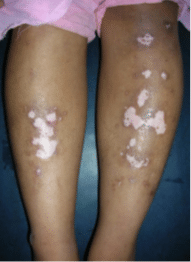
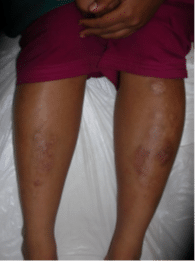
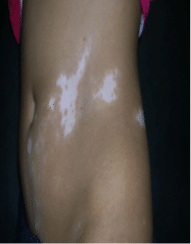
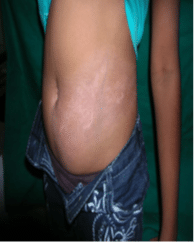
Topical corticosteroids
Corticosteroids are a type of medicine that contains steroids. Topical means that the medicine is applied to the skin, such as a cream or ointment.
Topical corticosteroids can be used for the treatment of vitiligo, but they can sometimes stop the spread of the patches and may restore some of your original skin colours.
Using topical corticosteroids
You may be prescribed a cream or an ointment, depending on what you prefer and where it will be used. Ointments tend to be greasier. Creams are better in your joints – for example, inside your elbows. Possible corticosteroids that may be prescribed include:
- betamethasone valerate or clobetasone
After one month, if your vitiligo is not improving or the treatment is causing side effects, you may need to stop using corticosteroids.
Side effects
Side effects of topical corticosteroids include:
-
- streaks or lines in your skin (striae)
- thinning of your skin (atrophy)
- visible blood vessels appearing (telangiectasia)
Non-steroid topical creams
Topical tacrolimus used twice daily for up to 6 months tacrolimus is a type of medicine called calcineurin inhibitor, which is normally used to treat eczema. It is particularly used if :
- your face is affected and you want further treatment
- you cannot use topical corticosteroids because of the risk of side effects
- you have segmental vitiligo and want further treatment
- treatment with topical corticosteroids has not worked
Tacrolimus may be used for children or adults with the condition.
They can cause side effects, such as:
- burning or painful sensations
- making the skin more sensitive to sunlight
- facial flushing (redness) and skin irritation if you drink alcohol
Phototherapy
Phototherapy (treatment with light) may be used for children or adults if:
- topical treatments have not worked
- the vitiligo is widespread
- the vitiligo is having a significant impact on their quality of life
Evidence suggests that phototherapy, particularly when combined with other treatments, has a positive effect on vitiligo.
This type of treatment is sometimes called PUVA (psoralen and UVA light).
Phototherapy may increase the risk of skin cancer because of the extra exposure to UVA rays.
Although you may be able to buy special sunlamps to use at home for light therapy, these are not recommended. They are not as effective as the phototherapy you will receive in hospital. The lamps are also not regulated, so may not be safe.
Skin grafts (Melanocyte cell Transfer) Dr Sagoo is the only doctor in the UK that carries out this procedure.
Transfer of a non-cultured melanocyte suspension
In this method, a thin skin graft specimen of the normal coloured skin is obtained from a donor site elsewhere on the body under local anaesthesia and the specimen is treated in order to detach the superficial part of the skin (epidermis). Melanocytes (the pigment-producing cells) are located in this layer of the epidermis.
The obtained epidermis as such is again mechanically treated in order to obtain a solution containing melanocytes. The vitiligo patches are braded with dermabrasion and the melanocyte containing solution is then applied to the dermabraded areas over the recipient site. A bandage is placed on the treated area which will remain untouched for a few days. Over the next 3 months, the area will become repigmented with 70-80 % success.
Excimer laser is performed after the lesion is healed, in order to stimulate the transferred melanocytes to proliferate and populate the grafted area.
Onset of Pigmentation
The onset of pigmentation usually occurs in 3–6 weeks and it can take 3–6 months for the patches to achieve significant pigmentation. Psoralen ultraviolet A (PUVA) with sunlight or phototherapy can be initiated after 3 weeks. Vitiligo patches that don’t recover even after 6 months will need to be transplanted again.
Advantages of Melanocyte Cell Transplantation
- Donor recipient ratio 1:10 i.e. with just 10 cm2 of donor size a vitiligo patch of 100 cm2 can be treated
- Excellent texture and colour matching
- No stuck-on look (as seen in split-thickness grafting) or cobblestoning (as in punch grafting)
- Large areas can be treated in a single session
- Patients can use cosmetic camouflage as early as 10 days postoperatively
Advantages
– Very large surface areas can be treated using this method from a small donor site
-This procedure can only be carried out if the vitiligo is stable that is no new vitiligo patches in the last 2 years.
Repigmentation success
Repigmentation chance of success is 70-80% repigmentation but there is a 20 % chance there will be no repigmentation. They can therefore opt for excimer to increase the chance of repigmentation.
Please note: this is a highly skilled treatment and Dr Sagoo is the only doctor in the UK that carries out this procedure. Melanocyte cell transfer procedure will only be carried out after formal assessment by Dr Sagoo to see if you are suitable and meet the criteria
How long does the Vitiligo treatment takes?
It takes around 2-3 hours for the procedure to be performed.
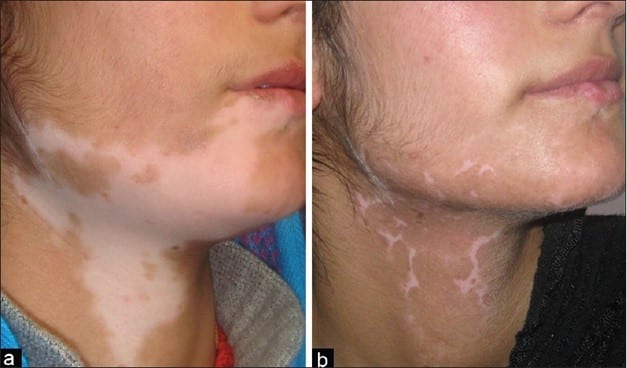
Image provided by La Verdad
For further information please contact the clinic on 03300 417494 on this exclusive procedure or contact us here.
